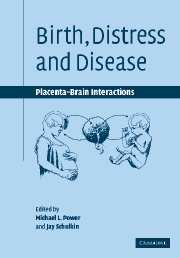Book contents
- Frontmatter
- Contents
- List of contributors
- Preface
- Introduction: brain and placenta, birth and behavior, health and disease
- 1 Placental expression of neurohormones and other neuroactive molecules in human pregnancy
- 2 The regulation of human parturition
- 3 Maternal nutrition and metabolic control of pregnancy
- 4 Fetal HPA activation, preterm birth and postnatal programming
- 5 Prenatal glucocorticoids and the programming of adult disease
- 6 Prenatal stress and stress physiology influences human fetal and infant development
- 7 Glucocorticoids and the ups and downs of neuropeptide gene expression
- 8 Glucocorticoid facilitation of corticotropin-releasing hormone in the placenta and the brain: functional impact on birth and behavior
- Index
5 - Prenatal glucocorticoids and the programming of adult disease
Published online by Cambridge University Press: 16 October 2009
- Frontmatter
- Contents
- List of contributors
- Preface
- Introduction: brain and placenta, birth and behavior, health and disease
- 1 Placental expression of neurohormones and other neuroactive molecules in human pregnancy
- 2 The regulation of human parturition
- 3 Maternal nutrition and metabolic control of pregnancy
- 4 Fetal HPA activation, preterm birth and postnatal programming
- 5 Prenatal glucocorticoids and the programming of adult disease
- 6 Prenatal stress and stress physiology influences human fetal and infant development
- 7 Glucocorticoids and the ups and downs of neuropeptide gene expression
- 8 Glucocorticoid facilitation of corticotropin-releasing hormone in the placenta and the brain: functional impact on birth and behavior
- Index
Summary
‘The Child is Father of the Man’, wrote British poet William Wordsworth (1807), reflecting upon the consistency of an individual's emotional responses through the long human lifespan. Soon afterwards, Mendelian and Darwinian genetics and the still controversial concept of early life programming indicated plausible biological bases for Wordsworth's artistic muse. Now, nearly two centuries later, many readily accept that part of our individual emotional compass is constrained by events affecting the development of the brain before birth, effects that persist for life, defining parameters upon which nurture and the adult environment exert their modifying effects. For genetics, the effects of classically inherited genes and chromosomal variation confirm the fundamental nature of inheritance of traits. Here we address the role of a specific aspect of the early life environment upon the lifelong characteristics of an individual, a much more recent addition to understanding of ‘ease or disease’ through our span.
Epidemiology and the concept of ‘programming’
To begin, in appropriate recent historical sequence, with human epidemiology. Numerous studies, initially in the UK and then encompassing much of the world, have demonstrated an association between lower birth weight and the subsequent development of the common cardiovascular and metabolic disorders of adult life, namely hypertension, insulin resistance, type 2 diabetes and cardiovascular disease deaths (Barker, 1991; Barker et al., 1993a, b; Fall et al., 1995; Yajnik et al., 1995; Curhan et al., 1996a, b; Leon et al., 1996; Lithell et al., 1996; Moore et al., 1996; Forsen et al., 1997; RichEdwards et al., 1997).
- Type
- Chapter
- Information
- Birth, Distress and DiseasePlacental-Brain Interactions, pp. 142 - 182Publisher: Cambridge University PressPrint publication year: 2005
- 1
- Cited by

